1.
Introduction
The micropolar fluid model is a qualitative generalization of the well-known Navier-Stokes model in the sense that it takes into account the microstructure of fluid [7]. The model was first derived in 1966 by Eringen [4] to describe the motion of a class of non-Newtonian fluid with micro-rotational effects and inertia involved. It can be expressed by the following equations:
where u=(u1,u2,u3) is the velocity, ω=(ω1,ω2,ω3) is the angular velocity field of rotation of particles, p represents the pressure, f=(f1,f2,f3) and ˜f=(˜f1,˜f2,˜f3) stand for the external force and moment, respectively. The positive parameters ν,νr,c0,ca and cd are viscous coefficients. Actually, ν represents the usual Newtonian viscosity and νr is called microrotation viscosity.
Micropolar fluid models play an important role in the fields of applied and computational mathematics. There is a rich literature on the mathematical theory of micropolar fluid model. Particularly, the existence, uniqueness and regularity of solutions for the micropolar fluid flows have been investigated in [6]. Extensive studies on long time behavior of solutions for the micropolar fluid flows have also been done. For example, in the case of 2D bounded domains: Łukaszewicz [7] established the existence of L2-global attractors and its Hausdorff dimension and fractal dimension estimation. Chen, Chen and Dong proved the existence of H2-global attractor and uniform attractor in [1] and [2], respectively. Łukaszewicz and Tarasińska [9] investigated the existence of H1-pullback attractor. Zhao, Sun and Hsu [18] established the existence of L2-pullback attractor and H1-pullback attractor of solutions for a universe given by a tempered condition, respectively. For the case of 2D unbounded domains: Dong and Chen [3] investigated the existence and regularity of global attractors. Zhao, Zhou and Lian [19] established the existence of H1-uniform attractor and further gave the inclusion relation between L2-uniform attractor and the H1-uniform attractor. Sun and Li [15] verified the existence of pullback attractor and further investigated the tempered behavior and upper semicontinuity of the pullback attractor. More recently, Sun, Cheng and Han [14] investigated the existence of random attractors for 2D stochastic micropolar fluid flows.
As we know, in the real world, delay terms appear naturally, for instance as effects in wind tunnel experiments (see [10]). Also the delay situations may occur when we want to control the system via applying a force which considers not only the present state but also the history state of the system. The delay of partial differential equations (PDE) includes finite delays (constant, variable, distributed, etc) and infinite delays. Different types of delays need to be treated by different approaches.
In this paper, we consider the situation that the velocity component u3 in the x3-direction is zero and the axes of rotation of particles are parallel to the x3 axis, that is u=(u1,u2,0), ω=(0,0,ω3), f=(f1,f2,0), ˜f=(0,0,˜f3). Let Ω⊆R2 be an open set with boundary Γ that is not necessarily bounded but satisfies the following Poincaré inequality:
Then we discuss the following 2D non-autonomous incompressible micropolar fluid flows with finite delay:
where ˉα:=c0+2cd>0, x:=(x1,x2)∈Ω⊆R2, u:=(u1,u2), g and ˜g stand for the external force containing some hereditary characteristics ut and ωt, which are defined on (−h,0) as follows
where h is a positive fixed number, and
To complete the formulation of the initial boundary value problem to system (3), we give the following initial boundary conditions:
For problem (3)-(5), Sun and Liu established the existence of pullback attractor in [16], recently.
The first purpose of this work is to investigate the boundedness of the pullback attractor obtained in [16]. We remark that García-Luengo, Marín-Rubio and Real [5] proved the H2-boundedness of the pullback attractors of the 2D Navier-Stokes equations in bounded domains. Motivated by [5] and following its main idea, we generalize their results to the 2D micropolar fluid flows with finite delay in unbounded domains. Compared with the Navier-Stokes equations (ω=0,νr=0), the micropolar fluid flow consists of the angular velocity field ω, which leads to a different nonlinear term B(u,w) and an additional term N(u) in the abstract equations (13). In addition, the time-delay term considered in this work also increases the difficulty.
The second purpose of this work is to investigate the upper semicontinuity of the pullback attractor with respect to the domain Ω. To this end, using the arguments in [15,17], we first let {Ωm}∞m=1 be an expanding sequence of simply connected, bounded and smooth subdomains of Ω such that ∞⋃m=1Ωm=Ω. Then we consider the Cauchy problem (3)-(5) in Ωm. We will conclude that there exists a pullback attractor ˆAˆH(Ωm) for the problem (3)-(5) in each Ωm. Finally, we establish the upper semicontinuity by showing limm→∞distE2ˆH(AˆH(Ωm)(t),AˆH(t))=0, ∀t∈R.
Throughout this paper, we denote the usual Lebesgue space and Sobolev space by Lp(Ω) and Wm,p(Ω) endowed with norms ‖⋅‖p and ‖⋅‖m,p, respectively. Especially, we denote Hm(Ω):=Wm,2(Ω).
(⋅,⋅)− the inner product in L2(Ω),H or ˆH, ⟨⋅,⋅⟩− the dual pairing between V and V∗ or between ˆV and ˆV∗. Throughout this article, we simplify the notations ‖⋅‖2, ‖⋅‖H and ‖⋅‖ˆH by the same notation ‖⋅‖ if there is no confusion. Furthermore, we denote
Following the above notations, we additionally denote
The norm ‖⋅‖X for X∈{E2ˆH,E2ˆV,E2ˆH×L2ˆV} is defined as
The rest of this paper is organized as follows. In section 2, we make some preliminaries. In section 3, we investigate the boundedness of the pullback attractor. In section 4, we prove the upper semicontinuity of the pullback attractor with respect to the domains.
2.
Preliminaries
In this section, for the sake of discussion, we first introduce some useful operators and put problem (3)-(5) into an abstract form. Then we recall some important known results about the non-autonomous micropolar fluid flows.
To begin with, we define the operators A,B(⋅,⋅) and N(⋅) by
What follows are some useful estimates and properties for the operators A, B(⋅,⋅) and N(⋅), which have been established in works [11,13].
Lemma 2.1. (1) The operator A is linear continuous both from ˆV to ˆV∗ and from D(A) to ˆH, and so is for the operator N(⋅) from ˆV to ˆH, where D(A):=ˆV∩(H2(Ω))3.
(2) The operator B(⋅,⋅) is continuous from V׈V to ˆV∗. Moreover, for any u∈V and w∈ˆV, there holds
Lemma 2.2. (1) There are two positive constants c1 and c2 such that
(2) There exists a positive constant α0 which depends only on Ω, such that for any (u,ψ,φ)∈V׈V׈V there holds
Moreover, if (u,ψ,φ)∈V×D(A)×D(A), then
(3) There exists a positive constant c(νr) such that
In addition,
where δ1:=min{ν,ˉα}.
According to the definitions of operators A,B(⋅,⋅) and N(⋅), equations (3)-(5) can be formulated into the following abstract form:
where
Before recalling the known results for problem (13), we need to make the following assumptions with respect to F and G.
Assumption 2.1. Assume that G:R×L2(−h,0;ˆH)↦(L2(Ω))3 satisfies:
(ⅰ) For any ξ∈L2(−h,0;ˆH), the mapping R∋t↦G(t,ξ)∈(L2(Ω))3 is measurable.
(ⅱ) G(⋅,0)=(0,0,0).
(ⅲ) There exists a constant LG>0 such that for any t∈R and any ξ,η∈L2(−h,0;ˆH),
(ⅳ) There exists CG∈(0,δ1) such that, for any t≥τ and any w,v∈L2(τ−h,t;ˆH),
Assumption 2.2. Assume that F(t,x)∈L2loc(R;ˆH), ∀t≥τ,τ∈R, and there exists a γ∈(0,2δ1−2CG) such that
In order to facilitate the discussion, we denote by P(X) the family of all nonempty subsets of X. Let D be a nonempty class of families parameterized in time ˆD={D(t):t∈R}⊆P(X), which will be called a universe in P(X). Based on these notations, we can construct the universe Dγ in the following.
Definition 2.3. (Definition of universe Dγ) Set
We denote by Dγ the class of all families ˆD={D(t) | t∈R}⊆P(E2ˆH) such that
where ˉBE2ˆH(0,ρˆD(t)) represents the closed ball in E2ˆH centered at zero with radius ρˆD(t).
Based on the above assumptions, we can recall the global well-posedness of solutions and the existence of pullback attractor of problem (13).
Proposition 2.1. (Existence and uniqueness of solution, see [13,16])
Let Assumption 2.1 and Assumption 2.2 hold. Then for any (win,ϕin(s))∈E2ˆH, there exists a unique weak solution w(⋅):=w(⋅;τ,win,ϕin(s)) for system (13), which satisfies
Remark 2.1. According to Proposition 2.1, the biparametric mapping defined by
generates a continuous process in E2ˆH and E2ˆV, respectively, which satisfies the following properties:
Proposition 2.2. (Existence of pullback attractor, see [16]) Under the Assumption 2.1 and Assumption 2.2, there exists a pullback attractor ˆAˆH={AˆH(t)|t∈R} for the process {U(t,τ)}t≥τ that satisfies the following properties:
∘ Compactness: for any t∈R,AˆH(t) is a nonempty compact subset of E2ˆH;
∘ Invariance: U(t,τ)AˆH(τ)=AˆH(t),∀t≥τ;
∘ Pullback attracting: for any ˆB={B(θ)|θ∈R}∈Dγ, it holds that
∘ Minimality: the family of sets ˆAˆH is the minimal in the sense that if
ˆO={O(t)|t∈R}⊆P(E2ˆH) is another family of closed sets such that
then AˆH(t)⊆O(t) for any t∈R.
Finally, we introduce a useful lemma, which plays an important role in the proof of higher regularity of the pullback attractor.
Lemma 2.4. (see [12]) Let X, Y be Banach spaces such that X is reflexive, and the inclusion X⊂Y is continuous. Assume that {wn}n≥1 is a bounded sequence in L∞(τ,t;X) such that wn⇀w weakly in Lq(τ,t;X) for some q∈[1,+∞) and w∈C([τ,t];Y). Then w(t)∈X and
3.
Boundedness of the pullback attractor for the universe Dγ
This section is devoted to investigating the boundedness of the pullback attractor for the universe Dγ given by a tempered condition in space E2ˆH. To this end, we consider the Galerkin approximation of the solution w(t) of system (13), which is denoted by
where the sequence {ej}∞j=1 is an orthonormal basis of ˆH and formed by eigenvectors of the operator A, that is, for all j≥1,
where the eigenvalues {λj}j≥1 of A are real number that we can order in such a way
It is not difficult to check that ξn,j(t) is the solution of the following ordinary differential equations:
Next we verify the following estimates of the Galerkin approximate solutions defined by (16).
Lemma 3.1. Let Assumption (2.1) and Assumption (2.2) hold. Then for any τ∈R,ϵ>0,t>τ+h+ϵ and (win,ϕin(s))∈AˆH(τ), we have
(ⅰ) the set {wn(r;τ,win,ϕin(s))|r∈[τ+ϵ,t]}n≥1 is bounded in ˆV;
(ⅱ) the set {wnr(⋅;τ,win,ϕin(s))|r∈[τ+h+ϵ,t]}n≥1 is bounded in L2ˆV;
(ⅲ) the set {wn(⋅;τ,win,ϕin(s))}n≥1 is bounded in L2(τ+ϵ,t;D(A));
(ⅳ) the set {w′n(⋅;τ,win,ϕin(s))}n≥1 is bounded in L2(τ+ϵ,t;ˆH).
Proof. Multiplying (18) by βnj(t) and summing them for j=1 to n, then using (7), (12) and Young's inequality, we obtain
Then integrating the above inequality over [τ,t],t≥τ, leads to
which implies
Thanks to (17), multiplying (18) by λjβnj(t) and summing the resultant equation for j=1 to n yields that
Observe that ‖un(t)‖≤‖wn(t)‖, ‖∇wn(t)‖≤‖wn(t)‖ˆV, using (10), (11) and Young's inequality, it is easy to see that
and
Therefore
Set
then we get
By Gronwall inequality, (21) yields
Integrating the above inequality for ˜r from r−ϵ to r, we obtain
Since
we can conclude that
which together with (19) and Assumption 2.2 implies the assertion (i).
Now, integrating (20) over [τ+ϵ,t], we obtain
which together with (19), Assumption 2.2 and the assertion (ⅰ) gives the assertion (ⅲ).
In addition,
which together with the assertion (ⅰ) yields the assertion (ⅱ).
Finally, multiplying (18) by β′nj(t) and summing the resultant equation for j=1 to n, we obtain
From Assumption 2.1, it follows that
By Lemma 2.2,
and
Taking (23)-(26) into account, we obtain
Integrating the above inequality, yields
which together with (20), Assumption 2.2 and the assertions (ⅰ)-(ⅲ) gives the assertion (ⅳ). The proof is complete.
With the above lemma, we are ready to conclude this section with the following H1-boundedness of the pullback attractor ˆAˆH for the universe Dγ.
Theorem 3.2. Let assumptions 2.1-2.2 hold and ˆAˆH={AˆH(t)|t∈R} be the pullback attractor of system (13). Then for any τ∈R,ϵ>0, t>τ+h+ϵ and (win,ϕin)∈E2ˆH, the set ⋃r∈[τ+h+ϵ,t]U(r,τ)AˆH(τ) is bounded in E2ˆV.
Proof. Based on Lemma 3.1, following the standard diagonal procedure, there exist a subsequence (denoted still by) {wn}n≥1 and a function w(⋅)∈L∞(τ+ϵ,t;ˆV)∩L2(τ+ϵ,t;D(A)) with w′(⋅)∈L2(τ+ϵ,t;ˆH) such that, as n→∞,
Furthermore, it follows from the uniqueness of the limit function that w(⋅) is a weak solution of system (13). According to compact embedding theorem, (28) and (29) implies w(⋅)∈C([τ+ϵ,t];ˆV). Then Theorem 3.1 follows from (27), Lemma 2.4 and Lemma 3.1.
Remark 3.1. We here point out that the boundedness of pullback attractor ˆA in E2D(A) can be proved by using similar proof as that in E2ˆV if we improve the regularity of F(t) and G(t,wnt) with respect to t, where D(A):=ˆV∩(H2)3. Exactly, assume that
(I) F(t,x)∈W1,2loc(R;ˆH), ∀t≥τ,τ∈R, and ∫t−∞eγθ‖F′(θ,x)‖2ˆV∗dθ<+∞.
(II) (G(t,ξ))′=dGdt: R×L2(−h,0;ˆH)↦(L2(Ω))3 satisfies:
∘ For any ξ∈L2(−h,0;ˆH), the mapping R∋t↦G(t,ξ)∈(L2(Ω))3 is measurable.
∘ (G(⋅,0))′=(0,0,0).
∘ There exists a constant ˜LG>0 such that for any t∈R and any ξ,η∈L2(−h,0;ˆH),
∘ There exists ˜CG∈(0,δ1) such that, for any t≥τ and any w,v∈L2(τ−h,t;ˆH),
Then we can deduce that the Galerkin approximate solutions {wn(⋅)}n≥1 is bounded in D(A)=ˆV∩(H2)3. Moreover, {w′n(⋅)}n≥1 is bounded in ˆH. Further, we can conclude the H2-boundedness of the pullback attractor ˆA.
4.
Upper semicontinuity of the pullback attractor
In this section, we concentrate on verifying the upper semicontinuity of the pullback attractor ˆAˆH obtained in Propositon 2.2 with respect to the spatial domain. To this end, first we let {Ωm}∞m=1 be an expanding sequence of simply connected, bounded and smooth subdomains of Ω such that ∞⋃m=1Ωm=Ω. Then we consider the system (3) in each Ωm and define the operators A,B(⋅,⋅) and N(⋅) as previous (in (6)) with the spatial domain Ω replaced by Ωm. Further we can formulate the weak version of problem (3)-(5) as follows:
On each bounded domain Ωm, the well-posedness of solution can be established by Galerkin method and energy method, one can refer to [7].
Lemma 4.1. Suppose Assumption 2.1 and Assumption 2.2 hold, then for any given (winm,ϕinm)∈E2ˆH(Ωm), system (30) has a unique weak solution wm satisfying
Moreover, the solution wm(⋅) depends continuously on the initial value winm with respect to ˆH(Ωm) norm.
According to Lemma 4.1, the map defined by
generates a continuous process {U(t,τ)}t≥τ in \widehat{H}(\Omega_m) . Moreover, on any smooth bounded domain \Omega_m , with similar proof as those of Lemma 3.2, Lemma 3.3 and Lemma 3.6 in [16], we can obtain the existence of pullback \mathcal{D}_{\gamma}^{\widehat{H}(\Omega_m)} -absorbing for the process \{U_m(t, \tau)\}_{t{\geq}\tau} and the pullback \mathcal{D}_{\gamma}^{\widehat{H}(\Omega_m)} -asymptotic compactness of the process in \widehat{H}(\Omega_m) . That is,
Lemma 4.2. Under the assumptions 2.1 and 2.2, it holds that
\mathrm{(1)} for any (w_m^{in}, \phi_m^{in}(s))\in E_{\widehat{H}(\Omega_m)}^2 , the family \widehat{\mathcal{B}}^{\widehat{H}(\Omega_m)} : = \big\{ \mathcal{B}^{\widehat{H}(\Omega_m)}(t) \, \big| \, t\in \mathbb{R} \big\} given by
is pullback \mathcal{D}_{\gamma}^{\widehat{H}(\Omega_m)} -absorbing for the process \{U_m(t, \tau)\} , where R_1(t) is bounded for all t \in \mathbb{R} .
\mathrm{(2)} for any \epsilon > 0 , there exist r_m: = r_m(\epsilon, t, \widehat{\mathcal{B}}^{\widehat{H}(\Omega_m)}) > 0 , \tau_m : = \tau_m(\epsilon, t, \widehat{\mathcal{B}}^{\widehat{H}(\Omega_m)})<t such that for any r \in [r_m, m], \tau {\leq} \tau_m ,
\mathrm{(3)} the process \{U_m(t, \tau)\}_{t{\geq}\tau} is pullback \mathcal{D}_{\gamma}^{\widehat{H}(\Omega_m)} -asymptotically compact in \widehat{H}(\Omega_m) .
Then based on the Remark 2.1 in [16], we conclude that
Theorem 4.3. Let assumptions 2.1 and 2.2 hold. Then there exists a pullback attractor \widehat{\mathcal{A}}_{\widehat{H}(\Omega_m)} = \big\{ \mathcal{A}_{\widehat{H}(\Omega_m)}(t) \, \big| \, t\in\mathbb{R} \big\} for the system (30) in \widehat{H}(\Omega_m) .
In the following, we investigate the relationship between the solutions of system (30) and (13). Indeed, we devoted to proving the solutions w_m of system (30) converges to the solution of system (13) as m\rightarrow\infty . To this end, for w_m\in \widehat{H}(\Omega_m) , we extend its domain from \Omega_m to \Omega by setting
then it holds that
Next, using the same proof as that of Lemma 8.1 in [8], we have
Lemma 4.4. Let assumptions 2.1-2.2 hold and \{(w_m^{in}, \phi_m^{in}(s))\}_{m{\geq} 1} be a sequence in E^2_{\widehat{H}(\Omega_m)\times L^2_{\widehat{V}(\Omega_m)}} converging weakly to an element (w^{in}, \phi^{in}(s))\in E^2_{\widehat{H}\times L^2_{\widehat{V}}} as m\rightarrow\infty . Then for any t {\geq} \tau ,
Based on Lemma 4.4, we set out to prove the following important lemma.
Lemma 4.5. Let assumptions 2.1-2.2 hold, then for any t\in\mathbb{R} , any sequence \{(w_m(t), w_{mt}(s))\}_{m{\geq} 1} with (w_m(\tau), w_{m\tau}(s)) = (w_m^{in}, \phi_m^{in}(s))\in\mathcal{A}_{\widehat{H}(\Omega_m)}(\tau), m = 1, 2, \cdots , there exists (w(t), w_{t}(s))\in\mathcal{A}_{\widehat{H}}(t) such that
Proof. From the compactness of pullback attractor, it follows that the sequence \{(w_m^{in}, \phi_m^{in}(s))\}_{m{\geq} 1} is bounded in E_{\widehat H}^2 . Hence, there exist a subsequence (denoted still by) \{(w_m^{in}, \phi_m^{in}(s))\}_{m{\geq} 1} and a (w^{in}, \phi^{in}(s))\in \mathcal{A}_{\widehat{H}}(\tau) such that
Further, according to Lemma 4.4 and the invariance of the pullback attractor, we can conclude that for any t\in\mathbb{R} , there exist a (w_m(t), w_{mt}(s))\in \mathcal{A}_{\widehat{H}(\Omega_m)}(t) with (w_m(\tau), w_{m\tau}(s))\in \mathcal{A}_{\widehat{H}(\Omega_m)}(\tau) and a (w(t), w_t(s))\in \mathcal{A}_{\widehat{H}}(t) with (w(\tau), w_{\tau}(s))\in \mathcal{A}_{\widehat{H}}(\tau) such that
Then, using the same way of proof as Lemma 3.6 in [16], we can obtain that the convergence relation of (37) is strong. The proof is complete. With the above lemma, we are ready to state the main result of this section.
Theorem 4.6. Let Assumption 2.1 and Assumption 2.2 hold, then for any t\in\mathbb{R} , it holds that
where \mathcal{A}_{\widehat{H}}(t) and \mathcal{A}_{\widehat{H}(\Omega_m)}(t) are the pullback attractor of system (13) and system (30), respectively.
Proof. Suppose the assertion (38) is false, then for any m = 1, 2, \cdots , there exist t_0\in\mathbb{R}, \epsilon_0 > 0 and a sequence (w_m(t_0), w_{mt_0}(s))\in\mathcal{A}_{\widehat{H}(\Omega_m)}(t_0) such that
However, it follows from Lemma 4.5 that there exists a subsequence
such that
which is in contradiction to (39). Therefore, (38) is true. The proof is complete.











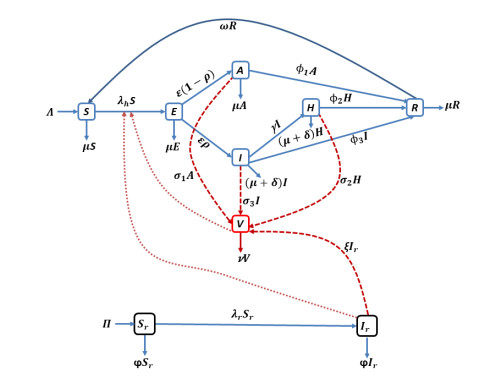
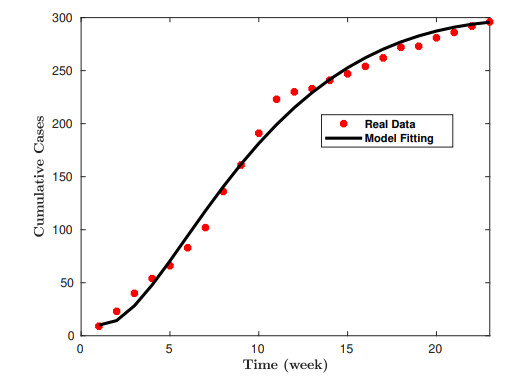
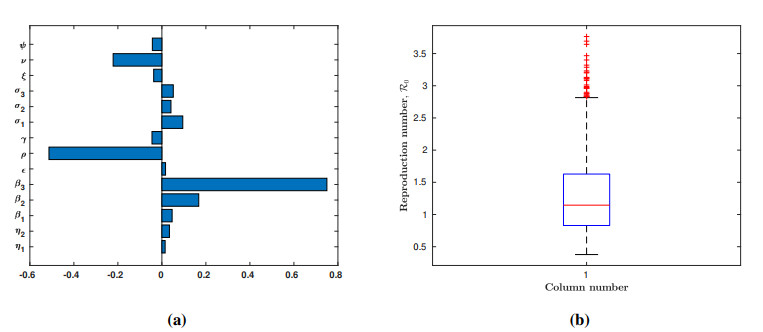
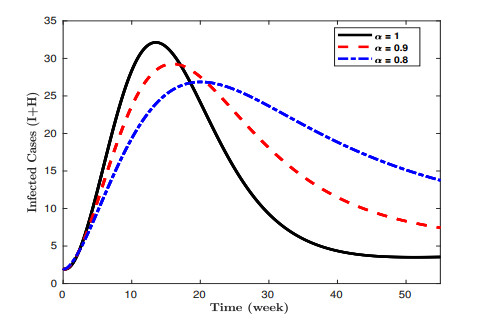
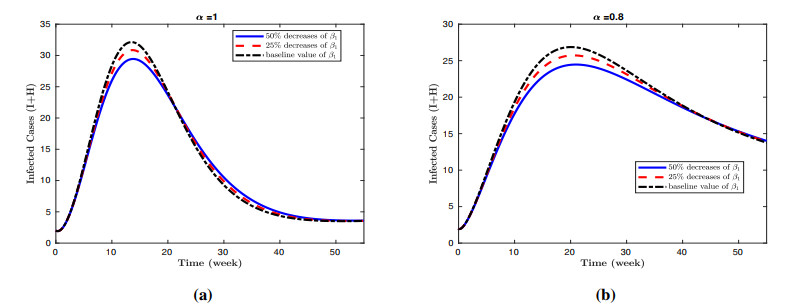
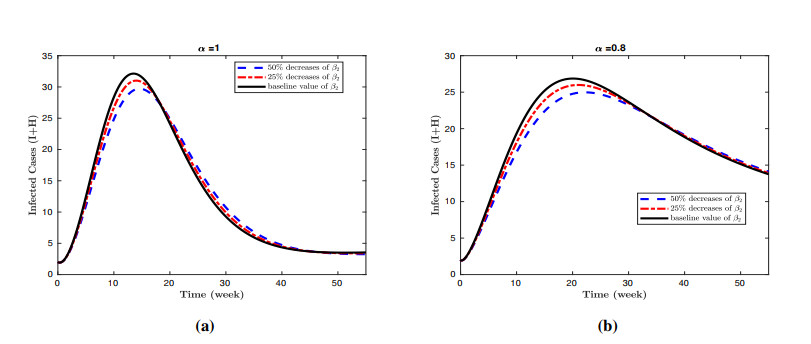
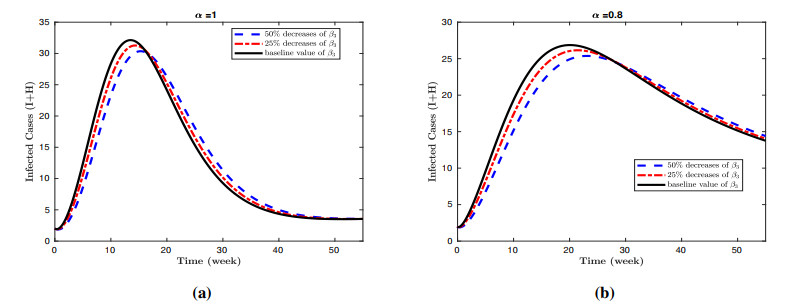


 DownLoad:
DownLoad: